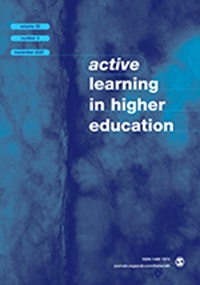Effects of embedded questions in pre-class videos on learner perceptions, video engagement, and learning performance in flipped classrooms
IF 3.8
1区 教育学
Q1 EDUCATION & EDUCATIONAL RESEARCH
引用次数: 4
Abstract
This study investigates the impact of embedded questions in pre-class instructional videos on learner perceptions (cognitive load, emotional engagement, satisfaction, judgement of learning), video engagement (total views, total viewing time), and learning performance (retention, transfer). The research occurred in a real flipped classroom environment. We designed a quasi-experiment in which 86 university students from two natural classes watched pre-class instructional videos featuring procedural knowledge with or without interpolated true or false questions. Students were asked to practice the operation steps introduced in the videos. While they practiced operations, they could either pause the videos or let the videos continue playing. Face-to-face contact time was utilised to consolidate and extend previewed content with student-centred, instructor-facilitated problem-solving activities. Results revealed no discernible effects from embedded questions in pre-class videos on cognitive load, emotional engagement, satisfaction, judgement of learning, total views, knowledge retention or knowledge transfer. We speculate that the various in-class practice activities and frequent access to procedural knowledge videos offset the cognitive benefits derived from question-embedded videos. Learners who viewed question-embedded videos presented significantly reduced total viewing time, likely because the embedded questions scaffolded them in sustaining attention and efficiently pinpointing the exact information needed. Future research should identify boundary conditions for embedding questions in instructional videos (e.g. learning mode, type of knowledge) rather than indiscriminately applying this design strategy.课前视频中嵌入问题对翻转课堂中学习者感知、视频参与度和学习表现的影响
本研究探讨课前教学视频中嵌入问题对学习者感知(认知负荷、情感投入、满意度、学习判断)、视频投入(总观看次数、总观看时间)和学习表现(记忆、迁移)的影响。这项研究发生在一个真实的翻转课堂环境中。我们设计了一个准实验,让来自两个自然班的86名大学生观看课前教学视频,这些视频以程序知识为特色,有或没有插入真假问题。学生们被要求练习视频中介绍的操作步骤。当他们练习操作时,他们可以暂停视频,也可以让视频继续播放。面对面的接触时间被用来巩固和扩展预习的内容,以学生为中心,教师促进解决问题的活动。结果显示,课前视频中嵌入的问题对认知负荷、情感投入、满意度、学习判断、总观点、知识保留或知识转移没有明显的影响。我们推测,各种课堂实践活动和频繁访问程序性知识视频抵消了嵌入问题视频带来的认知益处。观看嵌入问题视频的学习者的总观看时间明显减少,这可能是因为嵌入的问题帮助他们保持注意力,并有效地精确定位所需的确切信息。未来的研究应该确定在教学视频中嵌入问题的边界条件(例如,学习模式,知识类型),而不是不加选择地应用这种设计策略。
本文章由计算机程序翻译,如有差异,请以英文原文为准。
求助全文
约1分钟内获得全文
求助全文
来源期刊

Active Learning in Higher Education
EDUCATION & EDUCATIONAL RESEARCH-
CiteScore
13.20
自引率
12.00%
发文量
31
期刊介绍:
Active Learning in Higher Education is an international, refereed publication for all those who teach and support learning in higher education (HE) and those who undertake or use research into effective learning, teaching and assessment in universities and colleges. The journal is devoted to publishing accounts of research covering all aspects of learning and teaching concerning adults in higher education. Non-discipline specific and non-context/country specific in nature, it comprises accounts of research across all areas of the curriculum; accounts which are relevant to faculty and others involved in learning and teaching in all disciplines, in all countries.
 求助内容:
求助内容: 应助结果提醒方式:
应助结果提醒方式:


